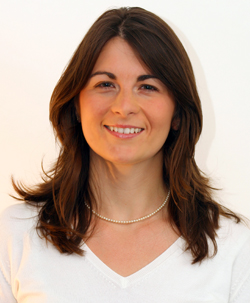
“My group specializes in using physics to study biological systems,” said Linda S. Hirst, an assistant professor of physics and researcher with FSU’s Center for Materials Research and Technology (MARTECH) and its Institute of Molecular Biophysics. “We aim to both understand fundamental biological processes, such as how cell membranes function, and also to develop new, interesting materials for technology that have been inspired by nature.”
Hirst’s research project, titled “Self-Assembly of Polyunsaturated Lipids and Cholesterol in the Cell Membrane,” has been awarded an NSF Faculty Early Career Development grant worth $572,831 over five years. According to its Web site, the NSF offers the awards “in support of the early career-development activities of those teacher-scholars who most effectively integrate research and education within the context of the mission of their organization.”
“This a very major achievement and further affirmation of Professor Hirst’s star quality,” said Mark Riley, chairman of the physics department at FSU.
A researcher in the field of soft-matter condensed experimental physics, Hirst
describes the cell membrane, or “bilayer,” as an extremely complex mixture of molecules that in many ways is not well understood.

“The bilayer controls the flow of chemicals in and out of the biological cell,” she said. “Therefore, it is vital for drug discovery and development that we know how it works. I am grateful to the NSF for providing me with the opportunity to continue this basic research for the next five years.”
In her lab at FSU and at Brookhaven National Laboratory in Upton, N.Y., Hirst and a team of undergraduate and graduate students are investigating how the arrangements of lipids—fat molecules, the main constituents of the bilayer—and cholesterol result in changes in cell membrane flexibility and permeability.
“We use X-ray diffraction techniques to study the arrangements of biological molecules at atomic length scales, combined with microscopy to study the same biological materials on a cellular level,” she said. “Our aim is to understand how the arrangements of single biological molecules can affect bulk properties.”
In related research, Hirst and three FSU colleagues—Professor Geoffrey F. Strouse of the Department of Chemistry and Biochemistry, and postdoctoral associate Jing Yuan and graduate research assistant Steven Hira, both of MARTECH—recently had a paper published in the prestigious Journal of the American Chemical Society. In that paper, titled “Lipid Bilayer Discs and Banded Tubules: Photoinduced Lipid Sorting in Ternary Mixtures” (link), the researchers discussed their development of a technique to create custom-shaped membranes in which flexibility and shape can be controlled.
“We are taking our inspiration from nature in creating artificial cell membranes and molding them into tiny chemical reactors,” Hirst said. “Understanding the properties of these membranes may provide a route to the generation of new, functional structures.”
Because the NSF Faculty Early Career Development grant is intended to augment educators’ educational as well as their research efforts, Hirst is developing a new course, “Biomedical Physics,” with the goal of combining physical science concepts with biological ones for FSU undergraduates who normally might have an aversion to physics.
“A key focus is to attract female undergraduate students majoring in life sciences to experience research in physics and to encourage them to pursue a career in biophysics,” she said.
Hirst also will teach an undergraduate course in condensed-matter physics that includes more-advanced topics in biomolecular assembly and soft matter, particularly cell membranes.
Finally, Hirst has created a Web site, “Soft Matter World” (www.softmatterworld.org), which she seeks to develop into the world’s foremost source of information related to soft-matter physics.
“It is admittedly an ambitious goal, but I would like to see the Web site become the first place that students and researchers all over the world look to for information or networking opportunities related to this rapidly growing field of research,” she said.
A complete description of Hirst’s NSF research project is available at www.nsf.gov/awardsearch/showAward.do?AwardNumber=0745786.




